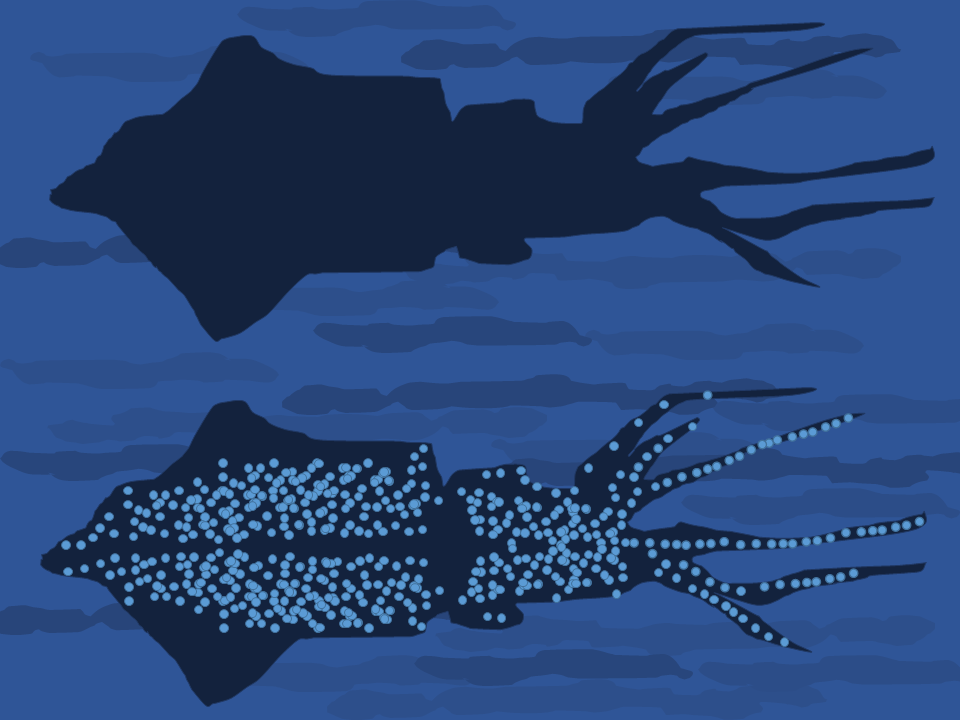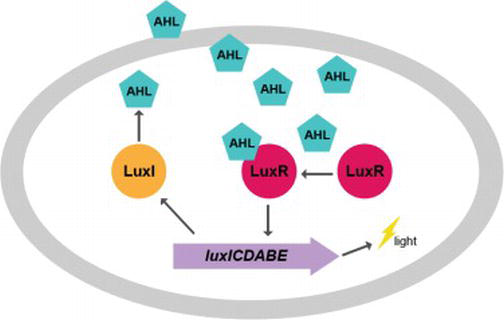|
Counter-illumination
Counter-illumination is a method of active camouflage seen in marine animals such as firefly squid and midshipman fish, and in military prototypes, producing light to match their backgrounds in both brightness and wavelength. Marine animals of the mesopelagic (mid-water) zone tend to appear dark against the bright water surface when seen from below. They can camouflage themselves, often anti-predator adaptation, from predators but also from their prey, by producing light with bioluminescence, bioluminescent photophores on their downward-facing surfaces, reducing the contrast of their silhouettes against the background. The light may be produced by the animals themselves, or by mutualism (biology), symbiotic bacteria, often ''Aliivibrio fischeri''. Counter-illumination differs from countershading, which uses only pigments such as melanin to reduce the appearance of shadows. It is one of the dominant types of aquatic camouflage, along with transparency and silvering (camouflage), ... [...More Info...] [...Related Items...] OR: [Wikipedia] [Google] [Baidu] |
Active Camouflage
Active camouflage or adaptive camouflage is camouflage that adapts, often rapidly, to the surroundings of an object such as an animal or military vehicle. In theory, active camouflage could provide perfect concealment from visual detection. Active camouflage occurs in several groups of animals, including reptiles on land, and cephalopod molluscs and flatfish in the sea. Animals achieve active camouflage both by Camouflage#Changeable skin coloration, color change and (among marine animals such as squid) by counter-illumination, with the use of bioluminescence. Military counter-illumination camouflage was first investigated during World War II for marine use. More recent research has aimed to achieve crypsis by using cameras to sense the visible background, and by controlling systems that can vary their appearance, such as coatings, or variable temperature infrared panels using the Peltier effect. In animals Active camouflage is used in several groups of animals including ceph ... [...More Info...] [...Related Items...] OR: [Wikipedia] [Google] [Baidu] |
Underwater Camouflage
Underwater camouflage is the set of methods of achieving crypsis—avoidance of observation—that allows otherwise visible aquatic organisms to remain unnoticed by other organisms such as predators or prey. Camouflage in large bodies of water differs markedly from camouflage on land. The environment is essentially the same on all sides. Light always falls from above, and there is generally no variable background to compare with trees and bushes. Near to the sea surface Reflection (physics), reflectivity and blue coloration are the most common form of camouflage. Below, countershading is more common, with blue coloration on the dorsal side, dorsal side and white on the ventral side. Below the epipelagic zone transparency is more frequent. In the aphotic zone red and black coloration are common, often in combination with bioluminescence. At the very deepest areas such as the Benthic zone, benthic regions of the hadal zone, most animals use pale red and cream colors. Camouflage in ... [...More Info...] [...Related Items...] OR: [Wikipedia] [Google] [Baidu] |
Silvering (camouflage)
Camouflage is the use of any combination of materials, coloration, or illumination for concealment, either by making animals or objects hard to see, or by disguising them as something else. Examples include the leopard's spotted coat, the battledress of a modern soldier, and the leaf-mimic katydid's wings. A third approach, motion dazzle, confuses the observer with a conspicuous pattern, making the object visible but momentarily harder to locate. The majority of camouflage methods aim for crypsis, often through a general resemblance to the background, high contrast disruptive coloration, eliminating shadow, and countershading. In the open ocean, where there is no background, the principal methods of camouflage are transparency, silvering, and countershading, while the ability to produce light is among other things used for counter-illumination on the undersides of cephalopods such as squid. Some animals, such as chameleons and octopuses, are capable of actively changing th ... [...More Info...] [...Related Items...] OR: [Wikipedia] [Google] [Baidu] |
Countershading
Countershading, or Thayer's law, is a method of camouflage in which animal coloration, an animal's coloration is darker on the top or upper side and lighter on the underside of the body. This pattern is found in many species of mammals, reptiles, birds, fish, and insects, both in predators and in prey. When light falls from above on a uniformly coloured three-dimensional object such as a sphere, it makes the upper side appear lighter and the underside darker, grading from one to the other. This pattern of light and shade makes the object appear solid, and therefore easier to detect. The classical form of countershading, discovered in 1909 by the artist Abbott Handerson Thayer, works by counterbalancing the effects of self-shadowing, again typically with grading from dark to light. In theory this could be useful for military camouflage, but in practice it has rarely been applied, despite the best efforts of Thayer and, later, in the Second World War, of the zoologist Hugh Cott. ... [...More Info...] [...Related Items...] OR: [Wikipedia] [Google] [Baidu] |
Cephalopod
A cephalopod is any member of the molluscan Taxonomic rank, class Cephalopoda (Greek language, Greek plural , ; "head-feet") such as a squid, octopus, cuttlefish, or nautilus. These exclusively marine animals are characterized by bilateral symmetry, bilateral body symmetry, a prominent head, and a set of cephalopod arm, arms or tentacles (muscular hydrostats) modified from the primitive molluscan foot. Fishers sometimes call cephalopods "inkfish", referring to their common ability to squirt Cephalopod ink, ink. The study of cephalopods is a branch of malacology known as teuthology. Cephalopods became dominant during the Ordovician period, represented by primitive nautiloids. The class now contains two, only distantly related, Extant taxon, extant subclasses: Coleoidea, which includes octopuses, squid, and cuttlefish; and Nautiloidea, represented by ''Nautilus (genus), Nautilus'' and ''Allonautilus''. In the Coleoidea, the molluscan shell has been internalized or is absent, where ... [...More Info...] [...Related Items...] OR: [Wikipedia] [Google] [Baidu] |
Yehudi Lights
Yehudi lights are lamp (electrical component), lamps of automatically controlled brightness placed on the front and leading edges of an aircraft to raise the aircraft's luminance to the average brightness of the sky, a form of active camouflage using counter-illumination. They were designed to aircraft camouflage, camouflage the aircraft by preventing it from appearing as a dark object against the sky. The technology was developed by the US Navy from 1943 onwards, to enable a sea-search aircraft to approach a surfaced submarine to "within 30 seconds of flying time" before becoming visible to the submarine's crew. This in turn enabled the aircraft to engage the submarine with depth charges before it could dive, to counter the Battle of the Atlantic, threat from German submarines to allied shipping. The concept was based on earlier research by the Royal Canadian Navy in its diffused lighting camouflage project. Yehudi lights were unused in the war and were made obsolete by advance ... [...More Info...] [...Related Items...] OR: [Wikipedia] [Google] [Baidu] |
Diffused Lighting Camouflage
Diffused lighting camouflage was a form of active camouflage using counter-illumination to enable Ship camouflage, a ship to match its background, the night sky, that was tested by the Royal Canadian Navy on corvettes during World War II. The principle was discovered by a Canadian professor, Edmund Godfrey Burr, in 1940. It attracted interest because it could help to hide ships from submarines in the Battle of the Atlantic, and the research project began early in 1941. The Royal Navy and the US Navy carried out further equipment development and trials between 1941 and 1943. The concept behind diffused lighting camouflage was to project light on to the sides of a ship, to make its brightness match its background. Projectors were mounted on temporary supports attached to the hull and the prototype was developed to include automatic control of brightness using a photocell. The concept was never put into production, though the Canadian prototypes did briefly see service. The Canadian ... [...More Info...] [...Related Items...] OR: [Wikipedia] [Google] [Baidu] |
Aliivibrio Fischeri
''Aliivibrio fischeri'' (formerly ''Vibrio fischeri'') is a Gram-negative, rod-shaped bacterium found globally in marine environments. This bacterium grows most effectively in water with a salt concentration at around 20g/L, and at temperatures between 24 and 28°C. This species is non-pathogenic and has bioluminescent properties. It is found predominantly in symbiosis with various marine animals, such as the Hawaiian bobtail squid. It is heterotrophic, oxidase-positive, and motile by means of a tuft of polar flagella. Free-living ''A. fischeri'' cells survive on decaying organic matter. The bacterium is a key research organism for examination of microbial bioluminescence, quorum sensing, and bacterial-animal symbiosis. It is named after Bernhard Fischer, a German microbiologist. ''Aliivibrio fischeri'' is the family '' Vibrionaceae.'' This family of bacteria tend to have adaptable metabolisms that can adjust to diverse circumstances. This flexibility may contribute to ''A. ... [...More Info...] [...Related Items...] OR: [Wikipedia] [Google] [Baidu] |
Bioluminescent
Bioluminescence is the emission of light during a chemiluminescence reaction by living organisms. Bioluminescence occurs in multifarious organisms ranging from marine vertebrates and invertebrates, as well as in some fungi, microorganisms including some bioluminescent bacteria, dinoflagellates and terrestrial arthropods such as fireflies. In some animals, the light is bacteriogenic, produced by symbiotic bacteria such as those from the genus '' Vibrio''; in others, it is autogenic, produced by the animals themselves. In most cases, the principal chemical reaction in bioluminescence involves the reaction of a substrate called luciferin and an enzyme, called luciferase. Because these are generic names, luciferins and luciferases are often distinguished by the species or group, e.g. firefly luciferin or cypridina luciferin. In all characterized cases, the enzyme catalyzes the oxidation of the luciferin resulting in excited state oxyluciferin, which is the light emitter of ... [...More Info...] [...Related Items...] OR: [Wikipedia] [Google] [Baidu] |
Squid Counterillumination
A squid (: squid) is a mollusc with an elongated soft body, large eyes, eight arms, and two tentacles in the orders Myopsida, Oegopsida, and Bathyteuthida (though many other molluscs within the broader Neocoleoidea are also called ''squid'' despite not strictly fitting these criteria). Like all other cephalopods, squid have a distinct head, bilateral symmetry, and a mantle. They are mainly soft-bodied, like octopuses, but have a small internal skeleton in the form of a rod-like gladius or pen, made of chitin. Squid diverged from other cephalopods during the Jurassic and occupy a similar role to teleost fish as open-water predators of similar size and behaviour. They play an important role in the open-water food web. The two long tentacles are used to grab prey and the eight arms to hold and control it. The beak then cuts the food into suitable size chunks for swallowing. Squid are rapid swimmers, moving by jet propulsion, and largely locate their prey by sight. They are amo ... [...More Info...] [...Related Items...] OR: [Wikipedia] [Google] [Baidu] |









